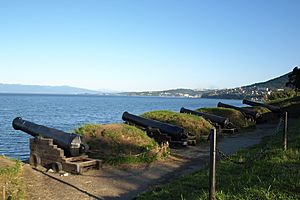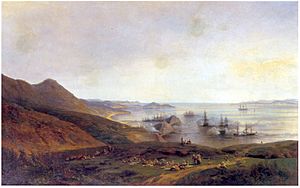Siege of Petropavlovsk facts for kids
Quick facts for kids Siege of Petropavlovsk |
|||||||
|---|---|---|---|---|---|---|---|
| Part of the Crimean War | |||||||
 Cannons which were used to defend Petropavlovsk in 1854 |
|||||||
|
|||||||
| Belligerents | |||||||
| Commanders and leaders | |||||||
| Strength | |||||||
6 warships
|
920–1,013 men (excluding officers) 40 shore cannons 1 frigate Aurora
|
||||||
| Casualties and losses | |||||||
2nd estimate
Enemy trophies:
|
37 killed 78 wounded 2 ships:
|
||||||
The Siege of Petropavlovsk was a major military event during the Crimean War in the Pacific Ocean. It was a battle between Russian forces and a combined British and French fleet. The Russians successfully defended their port. About 115 Russian soldiers and sailors were killed or seriously wounded. The British had 105 casualties, and the French had 104, according to official reports.
Contents
Why the Battle Happened
Allies Hunt Russian Ships
The British and French were worried that Russian warships in the Pacific might attack their trade ships. To stop this, the British and French navies joined forces. Rear-Admiral David Price led the British ships, and Rear-Admiral Auguste Febvrier-Despointes led the French.
In May 1854, their ships were in Peru when they got orders to find and fight Russian ships in the Pacific. The Russians had three possible bases: Novo-Arkhangelsk (now Sitka in Alaska), Okhotsk, and Petropavlovsk on the Kamchatka Peninsula.
Searching for Russian Bases
The allied fleet, made up of six ships with about 1,700 men and 200 cannons, first went to Novo-Arkhangelsk. They took the base easily, but no Russian warships were there. So, they sailed towards Petropavlovsk.
Russian Preparations for Defense
Russian Vice-Admiral Yevfimiy Putyatin knew his small fleet couldn't fight the allies at sea. He had only two ships: the 44-gun frigate Aurora and the 10-gun Dvina. He decided to gather all his forces at Petropavlovsk. The Dvina was used to bring soldiers from Okhotsk to help defend Petropavlovsk.
Another Russian ship, the 52-gun frigate Pallada, was hidden up the Amur River. Its captain removed all its cannons to make it lighter and hid it. Unfortunately, the ship was later destroyed by the frozen river during winter.
The First Attack on Petropavlovsk
Allied Ships Arrive
On August 28, 1854, the allied fleet arrived at Avocha Bay, near Petropavlovsk. Admiral Price used the steamship Virago to scout ahead. He saw that the Russians had moved their ships behind a strong, fortified piece of land in the bay.
Price decided to attack "Battery No. 2," which was a main defense for the Russian ships. The next day, the Virago and President fired at the Russian defenses to see how strong they were.
Admiral Price's Plan and a Sad Event
Admiral Price then held a meeting to share his plan. The attack would happen in two parts. First, they would destroy "Fort Shackoff" (Battery No. 1). Then, they would move around the land to attack Battery No. 2 and the Russian ship Aurora. Smaller allied ships would keep other Russian defenses busy.
On August 30, the wind was calm, so the Virago had to tow the sailing ships into position. During this movement, Admiral Price was fatally wounded in his cabin. Because of this, Captain Nicholson of the Pique ordered a 24-hour delay.
The First Bombardment Begins
On August 31, Admiral Price's plan was put into action. The President fired at Battery No. 1, the Forte at Battery No. 2, and the Virago and Pique at Battery No. 4. Batteries No. 1 and 4 were quickly silenced. A small group of British sailors landed and disabled the cannons at Battery No. 4.
The main allied force then moved to attack Battery No. 2. The ships President and Forte easily silenced Battery No. 2 and heavily damaged the Russian ship Aurora. The Aurora needed more than six months of repairs. The Virago was hit by a Russian shell, but the hole was quickly fixed. However, the French frigate Forte decided to pull back. The Virago towed it out of range, and the remaining allied ships also stopped their attack.
The Second Attack and Russian Victory
Planning a Land Attack
On September 1, the Virago went to bury Admiral Price. There, they met four American whalers who told them that Petropavlovsk could be attacked from the land side. There was a path through the woods of Nikalski Hill that would allow cannons to be brought up.
Meanwhile, the French commander, Admiral Febvrier-Despointes, and the British commander, Captain Nicholson, had a strong disagreement. Despointes wanted to retreat, but Nicholson believed the Russians were running out of ammunition and one more push would win. Since Despointes refused to put his ships back under enemy fire, Nicholson suggested a land attack.
The Land Attack Plan
The plan was to have the ships fire at the Russian defenses while about 700 men landed near Battery No. 6. One group would take Nikalski Hill and bring up small cannons to destroy the Aurora. The other group would fight through the town to take Battery No. 5, and then Battery No. 2.
The British captains voted to attack, while two French captains voted against it. Admiral Febvrier-Despointes didn't want to attack but didn't want the French to be called cowards. He chose not to vote, so the attack was approved.
The Landing and Battle
The attacking troops were put on the Virago, which towed the President, Forte, and smaller boats towards Battery No. 6. The attack groups included:
- French sailors (200 men)
- Marines (120 British and 80 French)
- British sailors (180 men)
- Mixed sailors (120 British and French)
The Petropavlovsk defenders had about 920 men, including soldiers, sailors, and local volunteers.
The President and Forte successfully silenced Batteries No. 2 and 3 in about 30 minutes. The troops landed in two waves. The British Marines quickly moved up the hill, and the British sailors successfully attacked Battery No. 5, destroying it.
However, the French commander, de la Grandière, couldn't find the path to bring cannons up the hill. He stayed on the beach and tried to call back the British groups.
Confusion and Retreat
By 8:45 AM, the British and French Marines had taken the top of the hill. The British sailors had moved into the town and were attacking the backs of Batteries No. 2 and 3. But de la Grandière tried to call back the Marines and took a long time to move his own group up the hill.
Meanwhile, a small group of mixed sailors came under heavy fire and were forced back. The Marines on the hill ran into strong Russian defenses with riflemen and cannons. They tried to fight back, but their officers were killed trying to lead a charge. When the French sailors finally arrived to help, they mistakenly fired at the British Royal Marines, thinking they were Russians.
The fighting on the hill lasted about 90 minutes. The Russians received reinforcements from other batteries and the town. Around 10:45 AM, de la Grandière ordered a retreat. The remaining Marines and French sailors were chased by Russian soldiers and sailors. The British force helped stop the Russian chase, but the attack had failed.
The landing parties returned to their boats on the beach. However, Russian riflemen on the heights continued to fire, causing more casualties as the troops boarded their boats. During this retreat, the Royal Marines' flag was lost when its bearer was shot and it fell overboard.
Aftermath of the Battle
The allies left behind 52 dead and wounded (26 British and 26 French). The Russians captured seven officers' swords and many firearms. The Royal Marine flag was found washed up on the beach the next day.
The allies retreated. They did manage to capture two small Russian ships, the Anadyr and the Sitka, on September 28, 1854. The allies left Petropavlovsk alone until April 1855. At that time, Nikolay Muravyov, knowing that Petropavlovsk didn't have enough troops or weapons to stop another attack, had the garrison leave the city secretly under the cover of snow.
The allied fleet went to Vancouver Island and San Francisco to regroup. They returned in the spring but found that the Aurora had already sailed away.
Casualties of the Battle
The British had 26 killed or missing and 79 wounded. The French had 26 killed or missing and 78 wounded. Some of these injuries were minor.
The official reports of casualties by ship were:
- President: 11 killed or missing, 2 seriously wounded, 28 bruised, 9 slightly wounded.
- Pique: 12 killed or missing, 7 seriously wounded, 11 bruised, 9 slightly wounded.
- Virago: 3 killed or missing, 3 seriously wounded, 3 bruised, 8 slightly wounded.
- Forte: 11 killed or missing, 18 seriously wounded, 10 slightly wounded/bruised. (This ship was the only one to have casualties in the first attack).
- Eurydice: 8 killed or missing, 11 seriously wounded, 10 slightly wounded/bruised.
- Obligado: 7 killed or missing, 10 seriously wounded, 18 slightly wounded/bruised.
In total, the allies had 52 killed or missing, 93 seriously injured, and 64 minor injuries.
The Russians had 37 dead and 78 seriously wounded. Minor Russian injuries were not usually reported.
Ships in the Allied Fleet
British Ships
The British force in September 1854 was led by Rear-Admiral David Price and included:
- HMS President, a 50-gun frigate (flagship), with 450 men.
- HMS Pique, a 40-gun frigate, with 280 men.
- HMS Virago, a 6-gun paddle steamer, with 149 men.
French Ships
The French force was led by Rear-Admiral Auguste Febvrier-Despointes and included:
- Forte, a 60-gun ship (flagship), with 513 men.
- Eurydice, a 30-gun ship, with 229 men.
- Obligado, a 14-gun ship, with 125 men.
Images for kids
-
HMS President – built to the plans of the American USS President






